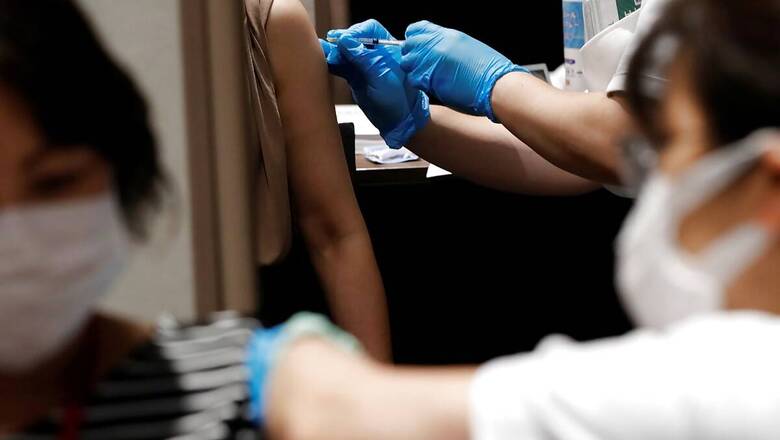
views
A gender divide is visible in India’s vaccination drive as more men are getting the jabs while women are lagging, however, Andhra Pradesh and Kerala are not following the national trend, as per the data from the CoWin portal.
India has vaccinated nearly 31 crore people for coronavirus till Saturday morning. The data analysed by CNN-News18 shows that only 46 per cent of these were women while nearly 54 per cent were men.
As per the CoWin portal, 30.96 crore people were vaccinated in India. Of these, 14.27 crore, or 46 per cent, were women. On the other hand, 16.69 crore men were vaccinated, accounting for 54 per cent of the total. Only 0.02 per cent amounting to 51,495 are in the ‘others’ category across India.
Out of the 21 States analysed by CNN-News18, only four States are vaccinating equal or more women.
While in Andhra Pradesh (53 per cent) and Kerala (52 per cent), more than half of the population vaccinated were women, for Chhattisgarh a few thousand more women were vaccinated when compared to the males, however, in terms of percentage they maintained a 50:50 ratio differing only by decimals.
In terms of numbers, out of 1.45 crore people vaccinated in Andhra Pradesh, 77.42 lakh were women while 67.69 lakh were men. In Kerala, which has vaccinated 1.33 crore people, 69.16 lakh women were vaccinated while 63.85 lakh men were given the jabs.
Similarly in Chhattisgarh, 36.52 lakh women were vaccinated against 35.87 lakh men. The total vaccination in the State was 72.41 lakh.
In Himachal Pradesh, while women account for roughly 50 per cent, they are slightly behind in terms of numbers. Out of the 33.30 lakh vaccinated population in Himachal Pradesh, 16.57 lakh were women while 16.71 lakh were men.
Meanwhile, the gender divide was the largest in Delhi and Uttar Pradesh among the 21 States. In these two States, only 42 per cent of the total vaccinated population are women, while men accounted for nearly 58 per cent of the vaccinated population, as per the data from the CoWin portal.
In Delhi, out of the total 71.21 lakh vaccinated population, only 29.76 lakh were women, while in Uttar Pradesh, out of 2.98 crore vaccinated population, only 1.26 crore were women.
Karnataka has vaccinated 2.13 crore people so far. Of this, 49 per cent, or 1.04 crore, were women, while 1.08 crore were men.
Out of the total 8.33 lakh people vaccinated in Goa, 48 per cent, or 3.97 lakh, were women. At least 4.36 lakh men were vaccinated in Goa.
In Rajasthan, out of the 2.36 crore people vaccinated, only 47 per cent, or 1.10 crore, were women. Rajasthan has vaccinated 1.26 crore men.
Only 46 per cent of the vaccinated population in Tamil Nadu, Maharashtra, Assam and Gujarat were women.
In Arunachal Pradesh, Haryana, Jharkhand and Bihar, the men-women ratio in vaccination were 55:45.
Similarly, for Madhya Pradesh and West Bengal, women accounted for 44 per cent of the total vaccinated population while in Chandigarh and Punjab, only 43 per cent of the vaccinated population were women.
On June 23, VK Paul, Member (Health), NITI Aayog, said India needs to inspire more women to get vaccinated. “We need to rectify this gender imbalance in all places where it exists. We need to bring more women forward for getting vaccinated,” he said.
It is also important to note that for those who may not have access to the internet or smartphones or even to mobile phones, free of cost on-site registration and vaccination is available at all government vaccination centres.
Further, as per the Union Health Ministry data, 80 per cent of all vaccine doses have so far been administered in an on-site vaccination mode.
In on-site, or walk-in vaccination, all the data recording for registration, vaccination and generation of certificates are done by the vaccinator. The beneficiary is only required to provide the basic minimum necessary information.
The Covid-19 vaccination coverage is found to be better in tribal districts than the national averages, the Union Health Ministry data says. Interestingly, while the male-female ratio for India stood at 54:46, in tribal districts it is 53:47.
Also, over 70 per cent of vaccination centres are located in rural areas.
India started its vaccination drive against the coronavirus infection on January 16.
Read all the Latest News, Breaking News and Coronavirus News here.
















Comments
0 comment